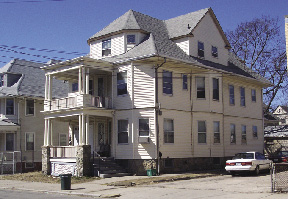As momentum grows for buildings with a reduced, or zero, carbon footprint, one sector has received little attention - affordable housing. Without significant improvement to that critical piece of existing building inventory, though, overall reductions in energy use will prove elusive.
Abode21 was created to address that issue.
A public/private collaboration of Stack Design Build, Distill Studio, R.I. chapter of the U.S. Green Building Council and CommunityWorks Rhode Island (CWRI). Abode21 will rehabilitate a foreclosed multi-family home into energy efficient affordable housing. Development of CWRI's property at 19 Stanwood St. has begun with ground-breaking scheduled for late summer.
Renovating 19 Stanwood St. will yield three energy efficient affordable housing units and create four to six jobs for roughly five months. While that represents an important step forward, the problems facing affordable housing stock and unemployment are so great that, on its own, this rehabilitation will not make a significant impact on the larger regional issues of jobs and the environment. To do that, the model has to be repeatable and scalable. The market requires a model with long-term value for both non-profit community development corporations and for-profit real estate developers.
To achieve that mission, Abode21 contains two distinct but mutually dependent components - the use of an innovative collaboration-based methodology known as integrated design and the development the Abode21 Education Initiatives.
The integrated design process makes this rehabilitation scalable at the market level. Issues are addressed when all stakeholders are assembled on day one, with project goals clearly defined by the group. Instead of each individual stakeholder focusing on a separate issue, the group's collective knowledge is brought to bear on all issues. This, in turn, produces efficiencies for the project and the environment with savings passed on to owners, tenants, and municipalities. This powerful proposition rarely occurs in the traditional construction process but is necessary to improve energy efficiency without introducing a "green premium." Because the integrated design process will provide a design, optimized for energy performance, without a significant cost premium, the 19 Stanwood St. renovation can be financed in its entirety through standard affordable housing finance channels.
Creating that model addresses the professional side of the equation, but without buy-in at the community level, there's limited large-scale benefit. Minimal progress comes from producing a "show piece" that benefits only a few fortunate families.
To tackle that side of the project, Abode21 has expanded its mission to include development of an education and outreach strategy. The team has enlisted Cutler and Company and V Street Media to craft a communication strategy and document the project. By leveraging CWRI's connection to the neighborhood, the entire community will soon have access to previously scarce information and resources related to reducing their energy costs and benefiting from a cleaner environment.
The combined impact of producing energy-efficient affordable housing in a neighborhood that genuinely needs and embraces it brings us one step closer to real reductions in green house gas emissions, creating a sustainable path to renovating a key segment of existing building stock.
Abode21 contributes to can bring the affordable housing sector up-to-speed with the rest of the market. Creating demand for energy-efficient, affordable housing in an urban community with limited resources and access to information on the need and benefits associated with reduced energy use is a big positive and continues the momentum towards building a green future.
Bill Via is a digital media consultant and owner of www.indieoma.com, Providence.
Tags:










